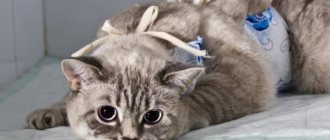Many people think that pet clothing is only for dogs. This is fundamentally not true, because lately more and more things have been appearing for cats and other pets. Most of the clothes are intended for walking short-haired cats and Sphynx cats. They freeze faster than others and need warmth. One of the necessary types of clothing for cats is a blanket after sterilization. This material will tell you how to sew a blanket for a cat after sterilization - the pattern and the sewing process itself.
Features of sewing clothes for cats
One of the features of sewing clothes for cats is the choice of materials. Everything here is very individual, since this particular fabric and this particular style will suit each individual cat. And it’s not just about the breed, but also about the coloring of the pet’s coat, the size of the pet, and even the place it occupies in the owner’s heart.
Cat apron
In any case, special attention should be paid to natural materials. It is also possible to use fabrics with a small amount of synthetic fibers. The best option would be: cotton fabrics, linen, wool, viscose. They are pleasant not only for humans, but also for cats. You should also look at the characteristics of the material: how well it is made, whether it fades in the sun, or whether it deforms after washing.
Bow and dress
Also among the features is taking measurements of cats, which, naturally, differ from dogs, and even more so from humans. Taking measurements from animals is not so easy, since they constantly strive to break free.
McDonald's apron version
How to choose a blanket
How long does it take for a cat to recover from anesthesia after sterilization: how you can help
The modern assortment includes a wide selection of blankets that not only protect the cat after surgery, but also warm it, and also protect furniture from the results of metabolic processes. For example, hairless cat breeds sweat a lot, leaving marks on furniture.
Note! When choosing, you should pay attention that the blanket is made from natural materials.
Velcro blanket option
The postoperative bandage should be made of dense cotton fabric and also have processed edges. Its classic version is represented by a rectangular bandage with cutouts for paws and ties for fixation. As an alternative, there are options with Velcro, which makes putting on easier.
How to take measurements from a cat
The main measurements to take are:
- neck girth. This is the circumference of the neck at its thickest and widest point. This is usually its base. To ensure an even measurement, it is necessary to place the animal on a flat surface;
- back length. The measurement is taken from the base of the neck to the beginning (root) of the ponytail. A centimeter placed along the spine is best suited for this;
- sternum girth. This measurement is taken around the widest part of the chest - under the front legs.
You might be interested in Patterns and DIY sewing of dresses in boho style
These measurements are enough for most products, but sometimes additional data is needed. For example, the distance between the paws.
Cat measurements
How to sew a post-operative blanket for a cat after sterilization
Blankets after sterilization are not always available for sale in veterinary pharmacies and other pet stores. If there is an urgent need for a post-operative bandage for a cat, then you can make it yourself. By looking at any pattern, you can make sure that there is nothing complicated in such a product, since it is a continuous piece of fabric with recesses for the paws and ropes for fixing it on the cat’s body.
DIY cat clothes without a pattern
Before making a blanket, you need to know the dimensions of the cat, which will be reflected in the diagram. Next, a pattern is made, on the basis of which a single piece is made from cotton fabric or flannel.
Important! It is recommended to use a light-colored fabric that immediately shows all dirt. This will help you consult a doctor in time if bleeding occurs due to a sudden divergence of the stitches.
Homemade blanket after sterilization surgery
Choosing fabric for blankets
The fabric must meet the following requirements:
- be soft and elastic, but not stretch too much;
- do not crumble or fall off in pellets, so as not to contaminate the wound, around which it is necessary to maintain sterility;
- be plain and preferably unpainted, so that dirt can be more easily seen.
Scheme of the blanket and options for its fastening
Velcro or ribbons - which is better?
The pros and cons of fasteners can be included in a separate section, since the process of their manufacture is always one of the most important. For some animals, Velcro is more suitable, and for others, ribbons are more suitable. This is based on the advantages and disadvantages of any type of fastening. Among the positive aspects of ribbons are:
- the ability to be made from the same fabric as the main part;
- ease of sewing;
- impossibility for the animal to untie them on its own.
An option for making a medium-sized blanket
. There are also disadvantages:
- the animal will cling to some objects in the room with them and play when the length is too long;
- you can overtighten the animal;
- Difficulty in untying if the knot is too tight.
Homemade blanket
Velcro also has its advantages and disadvantages. Among the advantages:
- ease of fixation;
- they are more compact compared to ribbons.
Flaws:
- their cost is higher;
- they quickly become dirty with wool;
- Easy to unfasten even for the most clumsy animal.
Blanket after surgery
Blanket for a cat: detailed instructions on how to sew and wear
To an inexperienced owner, a post-operative blanket for cats may seem like a rather complicated “thing” - rags, strings, holes of some kind. And why bother the cat with all these ties? If you are less nervous, you will get better faster. If your veterinarian forgot to show you how to tie a blanket for your cat, do not rush to violate the doctor's instructions. The blanket protects the seam from dirt - bacteria, germs, fungi, microorganisms. Inflammation of the suture is one of the main postoperative complications, do not risk your pet’s health!
Before sewing a blanket for a cat or buying a finished product, check with your veterinarian whether your pet needs additional protection. There are many technologies for suturing and postoperative treatment: sometimes a blanket is not only unnecessary, but can also harm the pet. Be sure to ask your veterinarian if a blanket is required.
Before you put a blanket on your cat, make sure that you have a quality product in front of you. You will not be allowed to check the bandage before purchasing (and if they are allowed, refuse to purchase - it is unknown how many people and with what hands touched the material that will come into contact with the seam). At the purchase stage, you can only choose the size - indicated on the packaging. A post-operative blanket for cats should fit perfectly, so measure your pet in advance: length from the base of the neck to the base of the tail, chest volume.
It’s great if the bandage is packaged in a transparent bag. Usually these are low-quality products, but high-quality blankets can be seen without opening the packaging. Pay attention to the seams - the stitching is perfectly even, no protruding threads. Since you need to tie a cat blanket so that the pet does not remove it, inspect the ribbons - they are thick enough, strong, securely attached to the bandage, and also without protruding threads. The edges of the bandage should also be stitched so that the material does not “crumble” - a small thread, if it gets on the seam and gets wet, will begin to rot. Many owners do not pay attention to the color of the blanket, and in vain. It is highly desirable that the bandage be white or as light a color as possible - the slightest dirt and moisture stains are visible on such material. Before putting a blanket on a cat, the owner will always notice if the material is dirty. The appearance of stains will serve as a signal - it’s time to change the bandage. Don’t forget to buy a spare blanket for a shift, or better yet, buy three at once, with a reserve.
It’s not difficult to sew a blanket for a cat with your own hands, but is it necessary? A bandage, even the highest quality, costs only about 150 rubles - a finished product made of non-woven medical material, reliable stitching and anatomically correct design. Overall, it's worth the money. In addition, one bandage is included in the cost of the operation (in any decent clinic). But if such a need suddenly arises, we offer a simple blanket pattern for a medium-sized cat:
Blanket pattern
The figure shows what measurements need to be taken: chest volume, torso length, distance between the legs (bottom, near the chest) and paw circumference (very approximately, the size of the semicircle is adjusted with ties). A similar drawing, but according to the standards of your pet, needs to be drawn on any paper - we get a pattern for a blanket for a cat. We transfer it to the fabric, not forgetting to allow allowance for stitching the edges. The bandage can be single-layer or dense, two-layer. The fabric is not shabby, durable, and does not fray (cotton, for example). The main thing is that the material can withstand the pressure of claws and allow air to pass through well, otherwise the seam will become damp and may fester. Don't forget to trim the edges of the fabric. The DIY cat blanket is almost ready. All that remains is to sew the ribbons (you can sew them by hand, but machine stitching is more reliable). The ribbons are strong, not fraying, without protruding threads. The ties must be able to withstand all the pet's somersaults, but not be so strong that the cat cannot break them with maximum effort.
A little about how to make a blanket for a cat as safe as possible. When tying ribbons, make sure that the loose ends are not too long. Usually cats, especially in the postoperative period, move carefully, but no one is immune from accidents: if a cat gets caught on a string, for example, on the handle of a bedside table, the consequences can be extremely disastrous. For the same reason, the tapes should not be too strong. If a cat gets caught on something, it should be able to break the tape (or the tape should burst itself if the cat hangs on it). Of course, it is better not to leave your pet unattended until it has fully recovered. When a cat removes the blanket, catching the material with its teeth or claws, the seam may come apart due to sudden movements and pressure - you will have to watch the pet around the clock or lock it in a box to limit maneuverability. You can try the Elizabethan collar, but most cats hate it even more than the bandage. The best option is to distract your pet with affection and switch her attention to something else. The hardest thing is to endure the first couple of days. Then, in most cases, cats stop paying attention to the ties and the strange thing “stuck” to their tummy.
How to put on a bandage?
To prevent the cat from removing the blanket, it is necessary to secure it correctly. Firstly, the tapes will make the task much more difficult - it will be impossible to slip out. Secondly, if the blanket fits comfortably, the cat is less irritated and quickly gets used to the forced “change of style.” So, how to properly tie a blanket on a cat so that the trickster cannot get rid of it? The package with the bandage always contains instructions and a similar drawing:
Scheme for putting a blanket on a cat
For convenience, all tapes are numbered. The cat is placed over a spread blanket or placed on its side, placing the edge of the blanket under the pet. The bandage should be adjacent to the chest and stomach, the tapes are on top, from the neck to the ponytail.
Procedure:
You might be interested in these articles:
Sewing blankets from improvised materials
Below we will describe how and from what you can make a blanket if you don’t have any suitable material or patterns at hand. You don't need any special cutting and sewing skills.
You might be interested in Description of bias tape: how to make it yourself
Scheme of overalls for a cat
Pantyhose blanket
The simplest option, which requires virtually no resources. There is only one rule: you need to use clean tights, since the animal definitely needs sterility after surgery and sterilization. It is recommended to use thick tights that will fit the cat's body well.
Important! The blanket is made like this: a piece of trouser leg 20 cm long is cut off and pulled over the cat’s belly. Additionally, you can make holes for the paws.
New Year's suit for the British
Sock blankets without ties
The product is made from socks or stockings in the same way. Find the perfect size sock and cut off the front to create a fabric tube. The cat's body is inserted into it, fixing its stomach.
For your information! The most remarkable thing is that even if you don’t have the appropriate sizes at home, you can always buy clean and new socks at any clothing store for a few tens of rubles.
Cat blanket from a baby bodysuit
Blanket from old children's clothes
Old children's clothing in the form of jumpsuits and vests also works well. You should choose something that fits comfortably on your body and is fixed on it. If you don’t have anything like this at hand, then you can make a blanket from an ordinary sleeve of a children’s jacket that stretches well.
Fashionable outfit with a hood
Towel blankets
The most common option involves making it from a simple cotton towel. A cut of the required length is made, and holes for the paws are cut out, based on the anatomical features of the cat. Holes are cut in it for the neck, paws and sometimes the tail. The final stage involves creating a cylinder by sewing the ends of the towel together or sewing on strings.
If the cat is to be sterilized, then you need to buy a blanket
Fabrics used
It is better to sew such bandages from several layers of fabric:
- top – decorative or waterproof;
- medium – insulating, made of soft and warm fabric;
- internal - underwear made of delicate knitwear or flannel fabric.
It is best to sew a blanket made of two or three layers with well-stitched edges and ribbons for ties. For the durability of such a product, it is better to take dense cotton fabrics. The ties are cut long, and during the fitting process their excess length is removed so that the animal does not get entangled in them. In order not to disturb the cat once again, you need to determine the location of the paws in advance. If there are serious wounds after sterilization surgery, a multi-layer bandage is placed under the bandage when putting it on.
What else can you make for your pet?
In addition to blankets, decorative and warming things are often sewn for cats: tuxedos, skirts, light clothes for summer and thick ones for winter. Each requires the use of certain materials and entry-level sewing skills.
Cat skirt
The tuxedo
A stylish accessory that will highlight the elegance of a slender and long cat. This jacket is made according to a simple pattern, but it looks very beautiful, and most importantly, it does not hinder the movement of the animal. For production you will need:
- white fabric (old shirt);
- black fabric (any cut);
- some red cloth;
- Velcro for fixation;
- tailor's tools in the form of scissors, chalk, sewing machine or hand sewing accessories.
Costume for a British kitten
Airy skirt
If a tuxedo is more suitable for keeping warm, then a skirt is more suitable for going out. Usually these outfits are made for show animals, which appear before spectators and judges in original outfits. Skirts as clothing have become increasingly popular lately. The most important thing is that for manufacturing you will need a few materials and ordinary tools:
- a piece of tulle;
- satin ribbon;
- scissors, needle and thread.
You might be interested in everything about manual sewing machines for leather sewing
Important! This set is quite enough to make a beautiful skirt for a cat like a tutu without diagrams or patterns.
Pattern of a dress for a cat
Emergency heating
It happens that clothes for a pet are needed extremely urgently and there is not enough time to create patterns, transfer them to fabric and sewing. To quickly warm up, you can use a regular sock. For production you will need:
- one warm sock;
- scissors;
- chalk.
The idea is to make a vest out of a sock. It is very similar to a blanket, but does not require sterility. A tube is made from a sock with holes for the paws. After which it is put on the cat.
Warm sock
Summer minimalism
For the warm season there is no need for warm clothes, so things for summer are aimed at decorating the cat in a certain style. Such accessories can include ties, bow ties, hats and many others. So, to sew a bow tie you will need:
- collar;
- needle, thread and scissors;
- fabric for the butterfly.
Dress for the sphinx
Using a simple pattern, you can make a beautiful dress for your hairless Sphynx cat. The most remarkable thing is that a dress of this kind can be made from just two pieces. First of all, the main part is made, and then the sundress, which is sewn to the base.
For your information! All this takes very little time, but looks very attractive. Do-it-yourself clothes for the sphinx, the patterns of which are presented in the picture below, can be made in a matter of hours.
Knitted suit on a Canadian cat
How to train a cat to wear clothes
Extra attributes are unusual for animals, even if they perform quite useful functions. If a cat rejects clothes, then at first you will have to do everything to get the pet used to it. There is one rule: it is necessary to accustom the animal to clothes from a very early age. This very quickly becomes a habit, and the outfit no longer causes rejection.
Important! If the cat is already an adult, then there is no need to be upset. It is worth putting things on it for just a couple of minutes a day, and then gradually increasing the time you spend in clothes. This will teach her not to be afraid of accessories.
DIY pattern and measurements for a Sphynx cat
Thus, patterning clothes for a cat is a simple process that does not require deep knowledge of sewing or the ability to handle highly specialized tools. Warm or decorative clothing for a pet can be made in a couple of hours, following precise step-by-step instructions.
When is it possible to remove the protective device early?
What to do if a cat takes off its blanket after sterilization is one of the most common questions that worries owners. Most often, this situation occurs 3-4 days after the operation. At this time, the cat begins to feel better, finds calmness and a desire to get rid of the interfering bandage.
Note! The bandage itself is selected before the animal is sterilized. This is the only way to buy the right size option.
Whether or not to return it after removal depends on the method of suturing:
- when using non-absorbable threads, which must be removed after 7-10 days, the blanket should be worn until this period. If the cat takes it off, it should be put on again;
- If threads were used for the internal and external seams, which should dissolve on their own, then it is recommended to look at the situation. If the operation took place more than 4 days ago, blood is not oozing from the stitches and lymph is not secreted, you do not need to wear a blanket.
Treatment of postoperative sutures
The most common mistake owners make is to remove the bandage after surgery and let the cat walk without it. Before such a desire arises, the possible consequences of abandoning the blanket and removing it prematurely should be studied. This behavior threatens:
- gnawing of threads with subsequent divergence of the seam;
- penetration of microbes and fungi into the wound;
- inflammatory processes and tissue decay;
- the onset of internal or external bleeding.
All these complications can occur immediately after premature removal of the bandage or on 2-3 days. If the following symptoms occur, you should contact your veterinarian:
- the cat shows unusual aggression;
- regularly removes and chews on the bandage;
- does not stand on its paws, afraid to move;
- vomiting, lethargy and fever are observed;
- the blanket is contaminated with blood or lymph;
- the presence of ulcers in places where the body and bandage come into contact.











